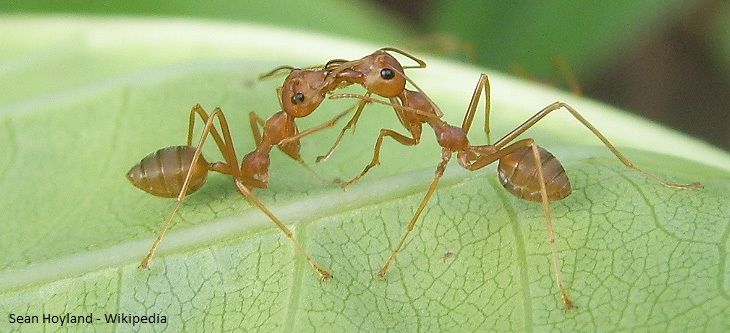In the intricate world of ants, communication is a vital aspect of their highly organized and cooperative societies. These tiny insects have evolved remarkable methods of conveying information to their fellow colony members, and one of the most fascinating forms of communication they employ is through chemicals. Known as chemical communication or semiochemical communication, this phenomenon plays a pivotal role in shaping the behavior and functioning of ant colonies.
Ants utilize chemicals called pheromones to transmit messages and coordinate various activities within their societies. Pheromones are secreted by specialized glands found on their bodies and serve as powerful signals that trigger specific responses in other ants. These chemical signals can convey information about food sources, colony defense, reproductive status, trail marking, alarm signals, and even help differentiate between nestmates and intruders.
One of the primary functions of chemical communication in ants is trail marking. When a foraging ant discovers a food source, it leaves a trail of pheromones along its path back to the nest. This chemical trail acts as a guide for other ants to follow, leading them directly to the food source. The strength and concentration of the pheromone trail can indicate the richness of the food, enabling efficient resource exploitation by the colony.
Furthermore, ants use pheromones to coordinate complex tasks, such as nest building and defense. For instance, during nest construction, certain ants release specific pheromones that signal the need for specific materials or the reinforcement of particular areas. This synchronized response ensures the colony's nest is efficiently built and maintained.
In terms of defense, ants employ alarm pheromones to alert their nestmates of potential threats or danger. When an ant detects a predator or an intrusion, it releases alarm pheromones, triggering a rapid response from nearby ants. This collective defense mechanism allows the colony to fend off threats effectively and protect their precious resources and young.
Another intriguing aspect of chemical communication is the ability of ants to recognize and differentiate between nestmates and non-nestmates. Each ant colony has a unique blend of pheromones known as the colony's "gestalt odor." This distinct scent is crucial for nestmate recognition and helps maintain colony integrity. When ants encounter individuals from other colonies or species, they can detect the foreign pheromones and respond aggressively to defend their territory.
The chemical communication system in ants showcases the remarkable complexity and efficiency of social insect societies. It enables ants to exhibit sophisticated behaviors, division of labor, and efficient resource allocation. By leveraging chemical signals, ants can collectively make decisions, adapt to changing environments, and optimize their survival and reproductive success.
Studying chemical communication in ants not only provides insights into the fascinating world of these small but mighty creatures but also has practical implications. Researchers and scientists have drawn inspiration from ant communication systems to develop effective pest control strategies, sustainable agriculture practices, and even robotics algorithms for swarm intelligence.
In conclusion, chemical communication in ants is a captivating phenomenon that underlies the coordination, cooperation, and success of ant colonies. Through the release and detection of pheromones, ants can transmit crucial information, establish efficient foraging trails, defend their colonies, and maintain social order. Exploring the intricate world of ant chemical communication not only deepens our understanding of these remarkable insects but also unveils the secrets of nature's intricate communication systems.
